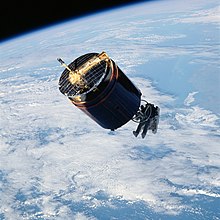Westar
Westarwas a fleet ofgeosynchronouscommunications satellitesoperating in theC bandwhich were launched byWestern Unionfrom 1974 to 1984. There were seven Westar satellites in all, with five of them launched and operating under the Westar name.
Background
[edit]Westar 1(launched on April 13, 1974) has the distinction of being the USA's first commercially launched geosynchronous communications satellite, following North America's first geosynchronous communications satellite,Canada'sAnik A1in 1972. Westar 1 was put into orbit at 99° W in theClarke belt(99° W now being the home ofGalaxy 16).
Westar 2 was launched shortly afterward on October 10, 1974. Westar 3, the first satellite to useTDMAswitched data, was launched on August 10, 1979. Westars 1, 2 and 3 were built byHughesusing theHS 333platform of spin-scan stabilized satellites. They only had 12transponderson board, as opposed to laterC-bandcommunications satellites having 24, and even contemporary satellites of the same era, such as RCA'sSatcom 1.

The later Westar 4 (launched on February 26, 1982) and Westar 5 (launched on June 9, 1982) satellites, were based on the Hughes HS 376 platform, and had 24transpondersavailable, as opposed to the 12 on Westars 1, 2, and 3.
Westar 6, also an HS-376 based satellite, was launched fromSTS-41-Bon February 3, 1984, to be put into service afterward, but the perigee kick motor (also known as thePayload Assist Module,or PAM) on the satellite failed during its approach to geosynchronous orbit, placing it at an improper and inoperablelow Earth orbit.It was retrieved on November 16, 1984, by theSTS-51-Amission ofNASA'sSpace Shuttle,where it was brought back to earth. It was then resold toAsiaSatinHong Kong,who refurbished it and relaunched it on April 7, 1990 asAsiaSat 1aboard aLong March 3rocket.[1]The Space Shuttle mission to retrieve Westar 6, as well as thePalapa B2satellite which shared the launchpayloadwith Westar 6, was partially funded by theinsurancecompanies led byLloyd's of Londonwho insured the launch of those two satellites.[2]
An on-ground spare satellite to Westar 6, Westar 6S, was in development by Western Union and Hughes when Western Union decided to divest themselves of theirtelecommunications-based assets starting in the early 1980s after suffering heavy financial losses. This resulted in Western Union selling the Westar satellite fleet and operations to Hughes in 1988.
Hughes then finished development of Westar 6S, and renamed it Galaxy 6. Modifications were made to it, and Galaxy 6 was launched on October 12, 1990.
Hughes later launched the Galaxy 4 satellite in 1992 and Galaxy 5 in 1993 to replace Westar 4 and 5 respectively, after the latter satellites reached the end of their useful life.
Uplink sites for Westar
[edit]During the life of the Westar fleet, Western Union operated these dedicated uplink sites (now defunct, unless noted) for Westar:
- The Yacoltearth stationatYacolt, Washington45°51′47″N122°23′44″W/ 45.86306°N 122.39556°W(45.8633,-122.3956). (now a satellite uplink site forVerizon Communications)
- The Sky Valley earth station, located nearCordelia, California38°09′39″N122°11′18″W/ 38.16083°N 122.18833°W[3](north ofSan Francisco)
- The Steele Valley earth station, nearPerris, California33°45′29″N117°18′54″W/ 33.75806°N 117.31500°W[4](southeast ofLos Angeles)
- The Kipapa earth station, nearWaipio Acres, Hawaii21°28′13″N157°58′21″W/ 21.47028°N 157.97250°W[5]
- The Cedar Hill earth station, atCedar Hill, Texas(nearDallas) (now a satelliteteleportstation once again, as the headquarters of All Mobile Video's Westar Satellite Services division[1])
- The Estill Fork earth station, at Estill Fork,Alabama34°54′30″N86°09′46″W/ 34.90833°N 86.16278°W[4]
- The Lake Geneva earth station, atLake Geneva, Wisconsin42°37′18″N88°25′55″W/ 42.62167°N 88.43194°W[4](northwest ofChicago)
- and the Glenwood earth station atGlenwood, New Jersey41°12′43″N74°29′38″W/ 41.21194°N 74.49389°W.[4]Glenwood was the head earth station for the Westar fleet, providing TT&C (telemetry, tracking & control) & uplink services. (Now the uplink site forSirius XM)
References
[edit]- ^"Westar 4, 5, 6".space.skyrocket.de.Retrieved30 November2020.
- ^"Seven Things You Might Not Know You Can Insure"(Web).The One Brief, Aon. February 2, 2017.RetrievedOctober 19,2017.
- ^Federal Register(PDF).Office of the Federal Register, National Archives and Records Service, General Services Administration. 4 April 1977. p. 19927.
- ^abcdPaul I. Wells (1978).Current Activities on Small Earth Terminal Satellite Domestic Telecommunications.Department of Commerce, National Telecommunications and Information Administration. pp. 80–.
- ^Federal Register.Office of the Federal Register, National Archives and Records Service, General Services Administration. 15 April 1971. pp. 8086–.
External links
[edit]- Description of the Westar satellites at Boeing Satellite System's (formerly Hughes) web site
- Gunter's Space Page - information onWestars 1, 2 & 3
- Gunter's Space Page information on4, 5, & 6
- Photos of the Westar Sky Valley earth station
- Map of terrestrial microwave relay sites of Western Union, including satellite uplink sites for Westar at the time
